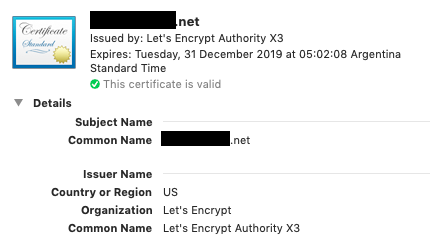FOP2 with SSL. Trouble and a clarification for docs.
In attempting to enable SSL, I set the path to the Lets Encrypt certificates, and restarted fop2 - but the secure socket does not seem to connect - does anything change about the socket?
I also tried adding debug / logging - I don't see anythign in the logs to indicate the files are being read / accessed / enabled SSL or not.
In my web config though there are 3 files:
SSLCertificateFile
SSLCertificateKeyFile
SSLCertificateChainFile
I entered only :
ssl_certificate_file
ssl_certificate_key_file
in fop2.cfg - the docs do not say to include the chain file, but they also don't say to ignore it.
Is there a way to test the config? I am still able to access without SSL, just not when I try https - I see the warning about secure socket not connecting.
If the chain file should be ignored that might be worth adding to the SSL notes.
Any pointers appreciated.
Thanks!!

Answers
Hi Mitch,
Did you try the suggestions as pointed in the FAQ?
http://www.fop2.com/docs/faq.php#IcannotconnecttoFOP2whileusingHTTPS/SSL
Here is the content/answer:
I cannot connect to FOP2 while using HTTPS/SSL
When you use SSL to connect to your web server, you must configure the FOP2 server to use the same SSL certificates as your web server in order for the browser to allow secure websockets connections. If not, then the browser will refuse negotiation of secure websockets.
So, you must edit your fop2.cfg file and add the proper certificate files. If you use stock FOP2, you can find your fop2.cfg file in /usr/local/fop2. If you installed it via RPM (Issabel, Ombutel), the file is in /etc/asterisk/fop2.
The settings you want to modify are:
If you use Letsencrypt SSL certificates, you might need to set them to something similar to this:
Most usually letsencrypt and certbot utilities will save the certificates on /etc/letsencrypt/live/www.yourdomain.com so the above settings would be correct (just use the correct domain name instead of yourdomain.com). If you are not sure, you can search for those files on your drive and be sure to set the accordingly on FOP2.
In order to find out which certificates are in use, if you use a Centos based system and Apache web server, you can run this command:
Inspect the output and look for the paramters SSLCertificateFile and SSLCertificateKeyFile, take note on their values and set them on the corresponding entries in fop2.cfg.
AFter the change, restart FOP2 with the command:
Yes for sure - that's what I was saying - but my curiousity was if a missing chain file mattered. Or where I'd see the SSL referenced in the debug output to find my error.
I have
ssl_certificate_file=/etc/letsencrypt/live/MYDOMAIN/cert.pem
ssl_certificate_key_file=/etc/letsencrypt/live/MYDOMAIN/privkey.pem
which are normal files used by apache in my httpd.conf and are current (i.e not expired).
I dont see any reference to cert.pem in fop2_debug.log
I do see a bunch of lines like this:
Not a reference at all
Not sure what that means though.
After enabling SSL non-SSL still works. No error except that the secure socket would not connect.
I don't see any obvious reason for a permission issue? Thought I looked.
lrwxrwxrwx 1 root root 42 Sep 1 00:05 /etc/letsencrypt/live/MYDOMAIN/cert.pem -> ../../archive/MYDOMAIN/cert15.pem
-rw-r--r-- 1 root root 2264 Sep 1 00:05 /etc/letsencrypt/archive/MYDOMAIN/cert15.pem
Cheers!
m
Hi,
On the server side, if debug is enabled (-X parameter, at least level 1), and if you have a permission issue with cert files or a misconfiguration on the .cfg file, you will see a messge like this on the FOP2 server debug log:
** SSL Certificate File cannot be read (/path/to/cert.pm). Disabling TLS
That's the only thing you can check on the server side. Then you have the client side (browser), and for that you must look at the developer/javascript console on the browser itself.
It appears you have things set correctly, and that should work. You must also be using the same hostname on the browser url than the one the certificate was issued, it might refuse to connect if you use an ip address or a local domain name instead of the actual hostname the certificate was issued for.
Best regards,
The main issue seemed to be net::ERR_CERT_COMMON_NAME_INVALID - but the cert "seems" ok.
The cert works in all browsers - it's form let's encrypt and is current / valid in terms of date.
The certificate has:
CN = DOMAIN.com
And Certificate subject alt name:
DNS Name=DOMAIN.com
DNS Name=www.DOMAIN.com
As an aside... I noticed in the errors there was also custom/theme/theme.css - does that mean potentially one can change the css using that?
Thanks!
What happens if you use the www.domain instead of just domain ?
I tried using both ways :-)
In firefox, and chrome.
https://DOMAIN.com
and
https://www.DOMAIN.com
Web pages can be viewed either way.
What are the cert details when you click on the lock icon on your browser? This is how it looks on a working site:

Here you go. Not at a desk at the moment. I can send you a public link I just hate leaving those in public forums...
Thanks!
Hi,
Your certificate has a subject alternative name defined, not sure if that is somehow affecting the websocket connection.
How did you obtain the certificate via Letsencrypt? any specific command to get that section? If you can catch me on the live help I would like to review your site (or send me a private message, not sure if this forum has such feature), and if possible I would like to try getting a certificate in the same way you did with yours.
Best regards,
Hi. Already sent you a "mail". It shows in the upper right by the envelope icon. But will send notes on our procedure for the request.